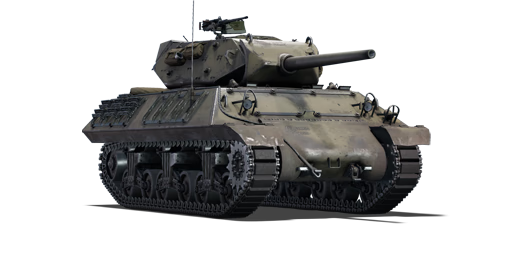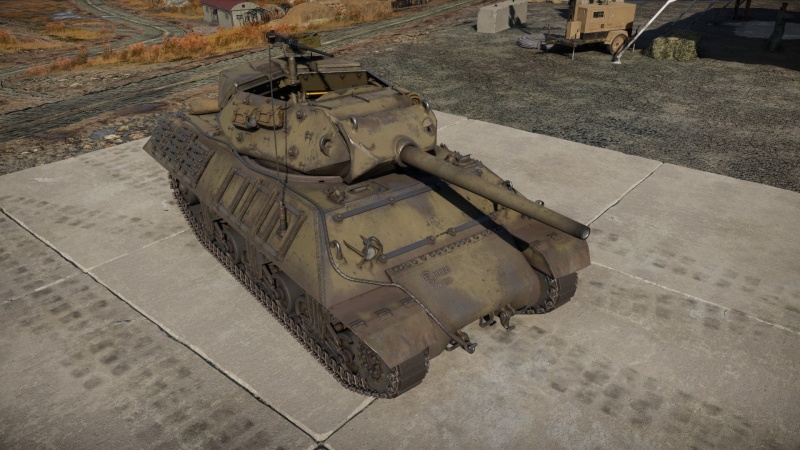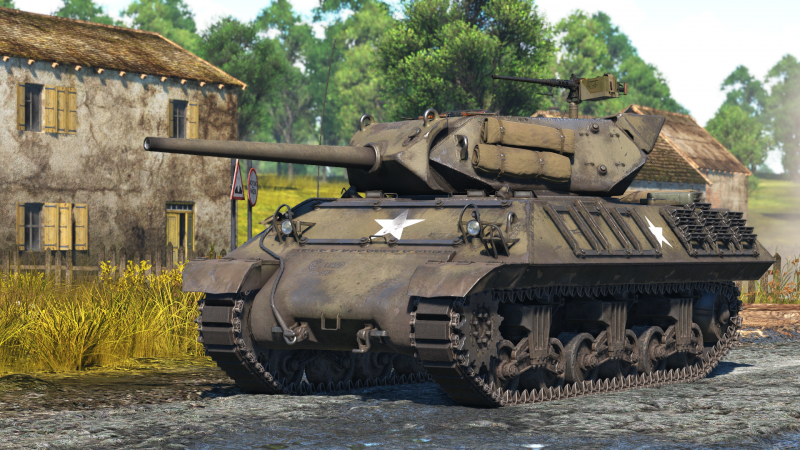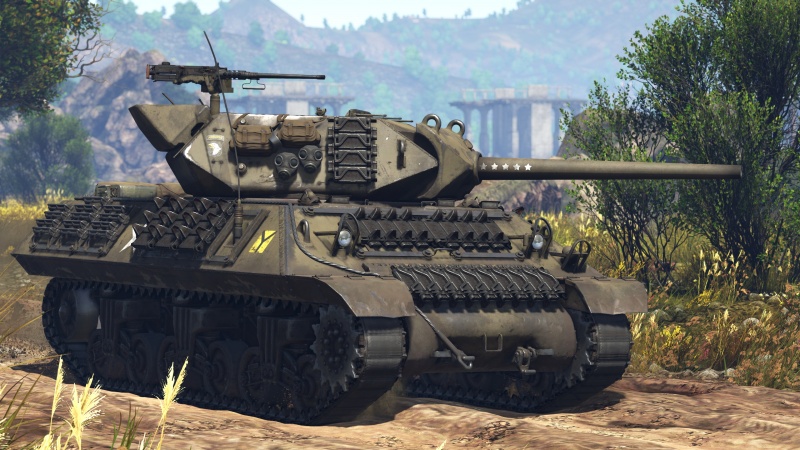Difference between revisions of "M10 GMC"
Colok76286 (talk | contribs) (Edits) |
(→Description) |
||
| Line 14: | Line 14: | ||
== Description == | == Description == | ||
<!-- ''In the description, the first part should be about the history of the creation and combat usage of the vehicle, as well as its key features. In the second part, tell the reader about the ground vehicle in the game. Insert a screenshot of the vehicle, so that if the novice player does not remember the vehicle by name, he will immediately understand what kind of vehicle the article is talking about.'' --> | <!-- ''In the description, the first part should be about the history of the creation and combat usage of the vehicle, as well as its key features. In the second part, tell the reader about the ground vehicle in the game. Insert a screenshot of the vehicle, so that if the novice player does not remember the vehicle by name, he will immediately understand what kind of vehicle the article is talking about.'' --> | ||
| − | The Fall of France | + | The Fall of France led the United States to frantically find ways to counter the new threat profile of the German panzer divisions. This led to the formation of the Tank Destroyer Branch whose main purpose was to blunt any German armoured exploitation attempts with a mobile tank destroyer force to eliminate the enemy tanks. The rapid creation led to placeholder vehicles like the 37 mm GMC M6 and [[M3 GMC|75 mm GMC M3]] to be put in service, but these were not ideal as the Tank Destroyer Branch sought a vehicle that could reach ideal positions faster than regular tanks. While such a [[M18 GMC|tank destroyer]] was in development, the urgency for a vehicle led to a conversion of a [[M4A2]] hull with a larger, open-topped turret carrying a high-velocity 3-inch gun into battle. This weapon system would be adopted as the '''{{Specs|name}}''' and would see service for all of World War II after its introduction in the Tunisian campaign. The M10 would also be famously known as the ''Wolverine'' in modern pop culture, though this is likely a post-war invention and not a term used during World War II. |
| − | Introduced in [[Update 1.49 "Weapons of Victory"]], the '''M10 GMC''' takes much from the [[M4A2]] Sherman which it was derived from. The drivetrain is identical with the drive shaft running from the engine in the rear to the front transmission and sprockets. The hull is sloped to a larger degree. The [[M7 (76 mm)|3-inch (76 mm) cannon]], originally mounted on the experimental M6 Heavy Tank, lacks the muzzle brake of the 76 mm M1A2 gun used on the later Rank III | + | Introduced in [[Update 1.49 "Weapons of Victory"]], the '''M10 GMC''' takes much from the [[M4A2]] Sherman which it was derived from. The drivetrain is identical with the drive shaft running from the engine in the rear to the front transmission and sprockets. The hull is sloped to a larger degree. The [[M7 (76 mm)|3-inch (76 mm) cannon]], originally mounted on the experimental M6 Heavy Tank, lacks the muzzle brake of the 76 mm M1A2 gun used on the later Rank III Shermans and the M18 Hellcat. The turret is a pentagonal shaped M5 Mount type. It has a powerful 76 mm gun; however it is held back due to the sluggish turret traverse speed. This severely limits the ability to quickly react and engage opponents when fired upon, a problem that can prove costly in high intensity matches. However, should any enemy come into the crosshair of the 3-inch gun, the M10 is very likely to put a penetrating hole in the enemy's armour. |
== General info == | == General info == | ||
Latest revision as of 20:12, 3 July 2024
| This page is about the American tank destroyer M10 GMC. For other versions, see M10 (Family). For other uses, see M10 (Disambiguation). |
Contents
Description
The Fall of France led the United States to frantically find ways to counter the new threat profile of the German panzer divisions. This led to the formation of the Tank Destroyer Branch whose main purpose was to blunt any German armoured exploitation attempts with a mobile tank destroyer force to eliminate the enemy tanks. The rapid creation led to placeholder vehicles like the 37 mm GMC M6 and 75 mm GMC M3 to be put in service, but these were not ideal as the Tank Destroyer Branch sought a vehicle that could reach ideal positions faster than regular tanks. While such a tank destroyer was in development, the urgency for a vehicle led to a conversion of a M4A2 hull with a larger, open-topped turret carrying a high-velocity 3-inch gun into battle. This weapon system would be adopted as the 3-inch Gun Motor Carriage M10 and would see service for all of World War II after its introduction in the Tunisian campaign. The M10 would also be famously known as the Wolverine in modern pop culture, though this is likely a post-war invention and not a term used during World War II.
Introduced in Update 1.49 "Weapons of Victory", the M10 GMC takes much from the M4A2 Sherman which it was derived from. The drivetrain is identical with the drive shaft running from the engine in the rear to the front transmission and sprockets. The hull is sloped to a larger degree. The 3-inch (76 mm) cannon, originally mounted on the experimental M6 Heavy Tank, lacks the muzzle brake of the 76 mm M1A2 gun used on the later Rank III Shermans and the M18 Hellcat. The turret is a pentagonal shaped M5 Mount type. It has a powerful 76 mm gun; however it is held back due to the sluggish turret traverse speed. This severely limits the ability to quickly react and engage opponents when fired upon, a problem that can prove costly in high intensity matches. However, should any enemy come into the crosshair of the 3-inch gun, the M10 is very likely to put a penetrating hole in the enemy's armour.
General info
Survivability and armour
Armour type:
- Rolled homogeneous armour
- Cast homogeneous armour (Gun mantlet, Transmission area)
- Structural steel (Counterweight)
| Armour | Front (Slope angle) | Sides | Rear | Roof |
|---|---|---|---|---|
| Hull | 38.1 mm (55°) 50.8 mm (7-55°) Transmission area |
19.05 mm (38°) Top 25.4 mm Bottom |
19.05 mm (28°) Top 25.4 mm (7-52°) Bottom |
19.05 mm Front 9.5 mm Rear |
| Turret | 25.4 mm (68-89°) Turret front 57.15 mm (0-47°) Gun mantlet |
25.4 mm (24-47°) | 25.4 mm (30-47°) Turret rear 50 mm (0-50°) Counterweight |
N/A |
Notes:
- Suspensions wheels are 20 mm thick, bogies are 10 mm thick, and tracks are 20 mm thick.
- Belly armour is 12.7 mm thick.
- Hull rear sides are protected by attached grousers that give 20 mm of extra armour.
The armour of the M10 is quite decent for the rank and can make shells ricochet when angled properly, but nonetheless, the armour is not thick enough to resist the stronger tank weapons of Rank II. The thickest part of the front hull is the 51 mm lower plate and the upper plate is 38 mm, though both are sloped at 55 degrees from vertical. The sides and back are only 19 mm, which is slightly angled and thus can be penetrated by most weapons stronger than a 12.7 mm machine gun. This fact is made worse by the positioning of ammo racks on the sides, making it easy to knock out the M10 in one hit with a side penetration. The turret has slightly better armour with the gun mantlet having 57 mm of armour angled at 45 degrees on the front, but it is still very weak on the sides and back. The front of the turret can often eat shells as the shell will fragment on the initial armour, and the massive breech of the 76 mm cannon will often absorb most if not all of the spalling, leaving the turret crew untouched. This will take the M10 out of combat, but when backed up by teammates it is possible to reverse away to repair. The turrets top is exposed and because of that artillery barrages and HE shells are much more lethal to the crew. One should avoid angling the armour a great degree as it may expose the weaker side armour at a more perpendicular angle.
For those fighting the M10 from the front, firing towards the upper left side of the hull glacis (towards the right from the firing perspective) will be able to knock out both the driver and/or gunner if the shot penetrates at the right angle. If this does not completely destroy the tank, it certainly has crippled it and the follow-up shot should go towards the opposite side to knock out the rest of the crew. Repeat if necessary in cases where the crews are still active inside the tank. It is also a good idea to shoot the bottom of the hull to disable the transmission if the M10 is trying to flee. Since the M10 is an open-topped tank destroyer, overpressure from HE rounds will have no problem dealing with the entire crew in a single shot, as long as the round hits the M10. When using HE against the front of the M10, aim center mass, as that will give you the strongest possibility of hitting it.
The M10's side is lined with ammo racks and it's extremely easy to knock out the tank with a single shot. Simply aim below the turret, shoot the side and the ammo should explode in a blaze of glory. If the ammo does not explode the first time, then try shooting the same spot again or aim more to the front of the hull to knock out any remaining crew. It is possible to blow up the fuel tanks or set it on fire by shooting the rear of the M10, the worse case at least the engine will be disabled.
There are not a lot of places to shoot at the back of the M10, though a shot at the turret can knock out the turret crew or a shot in the hull can cripple the engine. Two ammo racks are present at the rear of the turret, but these racks are most likely empty as 1) They are the first two to run dry and 2) Players will usually keep this empty with reduced ammo load. The best place to shoot in the rear would be the engine to immobilize the M10 and potentially set it on fire.
Mobility
The M10 has roughly the same mobility characteristics as the M4 Sherman. Spaded, the tank moves surprisingly fast in a straight line, but the turning speed is a bit sluggish as well as the reverse speed. The M10 struggles while driving on inclines due to its narrow tracks. All in all the M10's mobility is moderate and it can get to its location reasonably fast.
| Game Mode | Max Speed (km/h) | Weight (tons) | Engine power (horsepower) | Power-to-weight ratio (hp/ton) | ||||
|---|---|---|---|---|---|---|---|---|
| Forward | Reverse | Stock | AoA | Stock | Upgraded | Stock | Upgraded | |
| Arcade | 53 | 6 | 29.9 | 0.5 | 582 | 782 | 19.46 | 25.72 |
| Realistic | 49 | 5 | 363 | 410 | 12.14 | 13.49 | ||
Modifications and economy
First off, get all protection modifications: Parts and FPE. The M62 shell should be a top priority since it is superior to the stock M79 AP shot in all aspects. After that move on to research modifications from the Firepower tree: Horizontal Drive, Adjustment of Fire, and the Elevation Mechanism. Lastly research the Mobility tree: Tracks, Filters, Engine, Transmission, Suspension, Brake System.
Armaments
Main armament
The 3-inch (76 mm) cannon is a wonderful and powerful gun. APCBC ammo can penetrate any tank on the battlefield even from long range. It is not a bad idea to carry a few HE shells as well to fight lightly armoured and open top tanks like the M16 MGMC. The powerful gun and potent ammunition make the M10 a good sniper vehicle at its battle rating, especially with its -10° gun depression, giving the M10 the ability to maximize a hull-down position. Unfortunately, even though this tank destroyer does feature a turret, its turret rotation speed is extremely slow (< 4.0°/s) due to its historic configuration of only possessing a hand crank for the turret traverse. It is possible to crest a ridge and watch as the enemy rotates their turret, takes aim, and shoots the M10, all while the latter is rotating its turret into position. Thus, it is better to see it as a regular fragile SPG instead of a turreted SPG and fight from a distance and in possible concealment. Take warning that the gun's excellent penetration is too much for lower rank tanks and can lead to over-penetration, thus dealing less or even no damage to the enemy. Also, start each round with at least six missing shells (as detailed in the Ammo Racks section) to remove the ammo racks on the rear of the turret, reducing turret penetration vulnerability to an instant cook-off.
| 76 mm M7 | Turret rotation speed (°/s) | Reloading rate (seconds) | |||||||||||
|---|---|---|---|---|---|---|---|---|---|---|---|---|---|
| Mode | Capacity | Vertical | Horizontal | Stabilizer | Stock | Upgraded | Full | Expert | Aced | Stock | Full | Expert | Aced |
| Arcade | 54 | -10°/+30° | ±180° | - | 4.0 | 5.5 | 6.7 | 7.4 | 7.8 | 7.15 | 6.32 | 5.83 | 5.50 |
| Realistic | 2.7 | 3.2 | 3.8 | 4.2 | 4.5 | ||||||||
Ammunition
| Penetration statistics | |||||||
|---|---|---|---|---|---|---|---|
| Ammunition | Type of warhead |
Penetration @ 0° Angle of Attack (mm) | |||||
| 10 m | 100 m | 500 m | 1,000 m | 1,500 m | 2,000 m | ||
| M79 shot | AP | 134 | 132 | 121 | 109 | 99 | 89 |
| M42A1 shell | HE | 17 | 16 | 15 | 13 | 12 | 10 |
| M62 shell | APCBC | 149 | 146 | 133 | 119 | 106 | 94 |
| Shell details | ||||||||||||
|---|---|---|---|---|---|---|---|---|---|---|---|---|
| Ammunition | Type of warhead |
Velocity (m/s) |
Projectile mass (kg) |
Fuse delay (m) |
Fuse sensitivity (mm) |
Explosive mass (TNT equivalent) (g) |
Ricochet | |||||
| 0% | 50% | 100% | ||||||||||
| M79 shot | AP | 792 | 6.8 | - | - | - | 47° | 60° | 65° | |||
| M42A1 shell | HE | 853 | 5.84 | 0.2 | 0.1 | 390 | 79° | 80° | 81° | |||
| M62 shell | APCBC | 792 | 7 | 1.2 | 14 | 63.7 | 48° | 63° | 71° | |||
Ammo racks
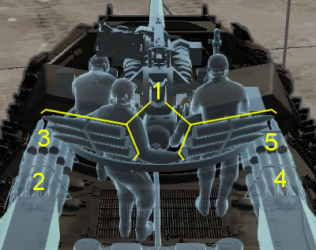
| Full ammo |
1st rack empty |
2nd rack empty |
3rd rack empty |
4th rack empty |
5th rack empty |
Visual discrepancy |
|---|---|---|---|---|---|---|
| 54 | 49 (+5) | 37 (+17) | 25 (+29) | 13 (+41) | 1 (+53) | No |
Note:
- As they are modeled by sets of 2, shells disappear from the rack only after you fire both shells in the set.
Machine guns
| 12.7 mm M2HB | ||||
|---|---|---|---|---|
| Mount | Capacity (Belt) | Fire rate | Vertical | Horizontal |
| Pintle | 400 (200) | 575 | -10°/+28° | ±60° |
Usage in battles
The M10 is a support vehicle. Find a good sniping position and lay behind the team taking out enemy tanks from a distance. Try to stay away from enemy tanks to avoid getting destroyed quickly. To make full use of its decent sniping capacity, find a spot that:
- overlooks key passageway / street / battle area
- is not too close to the frontline
- has slopes, hard covers or bushes
- is not too hard to get to
With a location like that, the M10 can utilise its -10° gun depression and use hull down. Its turret front and mantlet can consistently cause ricochets especially in a downtier. Looming behind bushes, an M10's well aimed shots should be able to knock out most enemy tanks at the battle rating range from long range. Even if you get spotted, any slope or hard covers will provide protection for you.
If fighting in a close quarters environment, do not try to push forward without support. Stay behind friendly tanks in order to support them without being shot at. If in an urban scenario on maps like Poland or Normandy, utilize the tank's turning speed to rotate the turret to the right angle. But, the best option is still to find a hull down location. For example, in Normandy, during arcade, the best location is towards the C point, where there are hills and dips that can be used to hide the hull, while giving a good view of the battlefield.
The M10 has a very slow turret rotation speed, but the M10 can traverse faster than it can rotate its turret and use its high speed when at high gear to produce some interesting skids via the physics engine to swerve the M10 and angle its gun at an enemy tank around the corner. It is recommended to understand and get a good feel of the M10's mobility and horsepower on dirt and paved roads before attempting this stunt. The low turret rotation speed means that a M10 player must always be aware of where the enemy tanks are, because they will not be able to turn the turret quickly if the enemy is able to flank the M10. In addition, the M10's side armour is weak, and the ammunition storage is in the hull sides, so if the enemy is able to shoot the M10 at that location, it is very likely to explode the ammo rack and destroy the tank with one shot.
Enemies worth noting:
8,8 cm Flak 37 Sfl.: also known as the "flak truck" or "flak bus", it is rather hard to knock out with armour-piercing shells because its armour is so thin that almost every shell will overpenetrate, dealing almost no critical damage. Additionally, this vehicle faces the side to aim the cannon, making it even harder to knock it out as the crew are all far apart. The flak truck can take quite a few hits and retaliate by taking out attackers one by one. Aim for the left side of its turret to disable its gunner first, then knock out the rest of its crew (right side of the turret & driving compartment). Do not rely on the M2 HB to knock out the crew: while it can penetrate the gun armour, the vehicle crew will be safe behind armour too thick to penetrate.
Pros and cons
Pros:
- Main cannon penetration and damage are very good for the rank, can knock out many tanks (e.g. T-34, KV-1 or even the Tiger H1) in one hit
- Mantlet sometimes absorbs shots with its sloped armour
- Good gun depression of -10°, perfect for hull-down positions
- Frontal glacis is somewhat bouncy due to its steep angle. Also, the huge, V-shaped gun mantlet can often bounce/absorb shells (e.g. 75 mm M3 and 76 mm F-34 / ZiS-5), as well as the large gun breech behind it further protecting the turret crew
- 5 crew members increase survivability
- Turreted purpose-built tank destroyer allows for a wide field of fire compared to casemate designs
- Powerful roof-mounted .50 cal M2 Browning can damage lightly-armoured vehicles or low-flying aircraft
- Access to modification "Add-on Armour", that increases hull protection significantly on the sides and front
- Has relatively no problem when getting uptiered
Cons:
- Mediocre turret traverse speed combined with its rather sluggish hull traverse "locks" it as a long-range sniper for most players. Close-quarters combat is difficult, as it often cannot get its gun on target in time
- Base armour is quite thin, and can get easily penetrated by common opponents
- Open-topped, vulnerable to aircraft strafing and artillery strikes
- Poor reverse speed won't save you from a dangerous encounter
- Only x3.5 gunsight zoom making it hard to shoot distant targets
History
Development
Conceived after the Battle of France, the US Army employed a doctrine to fight against the expected massed armoured attack the Germans had employed with their Panzer Divisions.[1] The doctrine called for a Tank Destroyer Branch that would be held in reserve to be deployed against an armoured attack. The first few vehicles produced on this concept was the 37 mm GMC M6 and the 75 mm GMC M3. While adequate, these were only seen as a stop-gap measure until better tank destroyers could be developed.[2][3] With requests being sent for a 3-inch Gun Motor Carriage (GMC), a proposal was made in November 1941 for a turreted tank destroyer that would use the chassis of M4A2 Sherman and armed with the 3-inch gun from the M6 heavy tank. The resulting prototype was standardized in June 1942 as the 3-inch Gun Motor Carriage M10 in June 1942.[2]
Production started on the M10s in September 1942 at Fisher Tank Arsenal at Grand Blanc, Michigan with a production priority rating much higher than even the new M4 medium tank. Due to the concerns of not meeting production demands, a separate variant developed on the M4A3 chassis as the M10A1. Production of these two vehicles would run until December 1943 (M10) and January 1944 (M10A1) for a total production number of 6,706 vehicle produced, 4,993 M10s and 1,713 M10A1s.[2]
Today, the M10 is often referred to as the "Wolverine". However, the origin of this nickname is unknown. Some have contested that it was a British nickname, but it is unlikely as they gave it the designation "Achilles". It also is not an American nickname as well as all official documents referred to the M10s by their designation or "TD". It is widely accepted that "Wolverine" is a post-war nickname similar to the "Hetzer" nickname on the Jagdpanzer 38(t).[2]
Combat usage
The M10 received their baptism of fire in Tunisia, with the Tank Destroyer putting their doctrine into practice at the Battle of El Guettar on 23 March 1943 against the 10th Panzer Division. Afterwards, the Allies found themselves on the offensive while large-scale German armoured punches became sporadic and scarce. Discontent with valuable guns and vehicles being left in reserves, a tactic was devised by Lt.Col. James Barney of the 776th to use the M10 in an artillery role with their 3-inch guns, a role the M10 found itself in during the fighting in Italy.[2]
The M10 was also deployed as the standard equipment in 11 Tank Destroyer battalions during Operation Overlord, serving alongside M18 GMC Hellcats and towed guns in the same tank destroyer role. Due to once again the armour engagements in Normandy and the rest of France to being scarce, the M10 found themselves supporting infantry advances into German territory. In July, encounters with Panther tanks shocked the tank destroyer crew as there was a belief the armaments were capable of easily dealing with the new German tanks, and complaints were made for the fielding of a better gun on the field. The solution came in the form of the M36 GMC Jackson with a 90 mm cannon and the T4 HVAP ammo for the 3-inch gun.[2]
Towards the end of 1944, the German Ardennes Offensive (Battle of the Bulge) caused the M10 and the other employed tank destroyers to face off once again against a dedicated armoured punch of Panthers and Tiger II tanks. During this campaign, a deception mission was launched by the Germans named Operation Grief, which had ten Panther tanks dressed up to look like M10s externally to fool Americans.[4] All of these mock-ups were destroyed by battle or scrapped after it. After the Battle of the Bulge, the majority of German armoured forces have dwindled and armour engagements largely declined in the final months of the war in Europe.[2] One of the M10's most notable action in 1945 was done on January 26 in the Colmar Pocket when the most decorated soldier of World War II, Audie Murphy, used a knocked out M10's M2 Browning machine gun to hold off a German counterattack of six tanks plus infantry while calling in artillery. He held for an hour and killed about 50 German soldiers from behind the burning M10 wreck, forcing the tank units to retreat due to loss of infantry support. Audie Murphy was awarded the Medal of Honor for his actions.[5][6]
The M10s were a part of the American Lend-Lease program to the Allies and as such many M10s found their ways into British, Free French, and Soviet hands. In all, 1,855 M10s were sent in the Lend-Lease program, of which 1,648 were to Great Britain. The British designated the M10s as the 3" SPM (Self-Propelled Mount) M10. The most famous of the British usage of the M10 was the conversion of the armament into the 17-pounder gun. These converted M10s were designated M10C or M10 17-pdr under British nomenclature, though they did issue a name Achilles to designate all forms of M10 under British service.[2]
After the end of World War II, most M10s were scrapped or given away as part of the Military Assistance Program to other allies.[2]
| Archive of the in-game description | |
|---|---|
|
A self-propelled artillery/anti-tank mount based on the Sherman tank. A new open turret featuring a more powerful gun, but only manual targeting, was installed on it. It was released from September 1942 to January 1944 and proved to be quite effective in combat against German medium tanks. However, it was not powerful enough to stand up to the Tiger or Panther. And also... Due to its open turret it was vulnerable to artillery barrages and in battles in populated areas. It was frequently used as a standard linear tank. | |
Media
- Skins
- Videos
See also
- Vehicles equipped with the same chassis
External links
- [Devblog] Attacker FB.1 and M10 & M36 Slugger
- [Wikipedia] M10 tank destroyer
- [Tanks Encyclopedia] 3in GMC M10 Wolverine
- RideR2's Realistic gunsight (M76 & M71C & M71D) for M4 Shermans with 76 mm cannon, M10, M36, T25 and M26 Pershings
References
- Citations
- Bibliography
- Hart, Stephen A. Panther Medium Tank 1942-45. Great Britain: Osprey Publishing Ltd., 2003
- Moran, Nicholas. "US Tank Destroyer History." YouTube. YouTube, 26 Aug. 2016. Web. 08 Feb. 2017. Video
- Smithsonian Institution. "The Price of Freedom: Audie Murphy's Medal of Honor Citation." The Price of Freedom: Audie Murphy's Medal of Honor Citation. N.p., n.d. Web. 24 Feb. 2017. Website
- Walker, Dale L. "Audie Murphy: To Hell and Back." United Service Organizations. N.p., 20 Sept. 2015. Web. 24 Feb. 2017. Website
- Zaloga, Steven J. M10 and M36 Tank Destroyers 1942-53 Great Britain: Osprey Publishing Ltd., 2002
- Zaloga, Steven J. M18 Hellcat Tank Destroyer 1943-97 Great Britain: Osprey Publishing Ltd., 2004
| USA tank destroyers | |
|---|---|
| M10 | M10 GMC |
| M36 | M36 GMC · M36B2 |
| T95 | T28 · T95 |
| M109 | M109A1 |
| ATGM | LOSAT · M901 |
| Wheeled | M3 GMC · T55E1 |
| Other | M8 HMC · M50 · M56 |
| China | ▃LVT(A)(4) (ZIS-2) |


